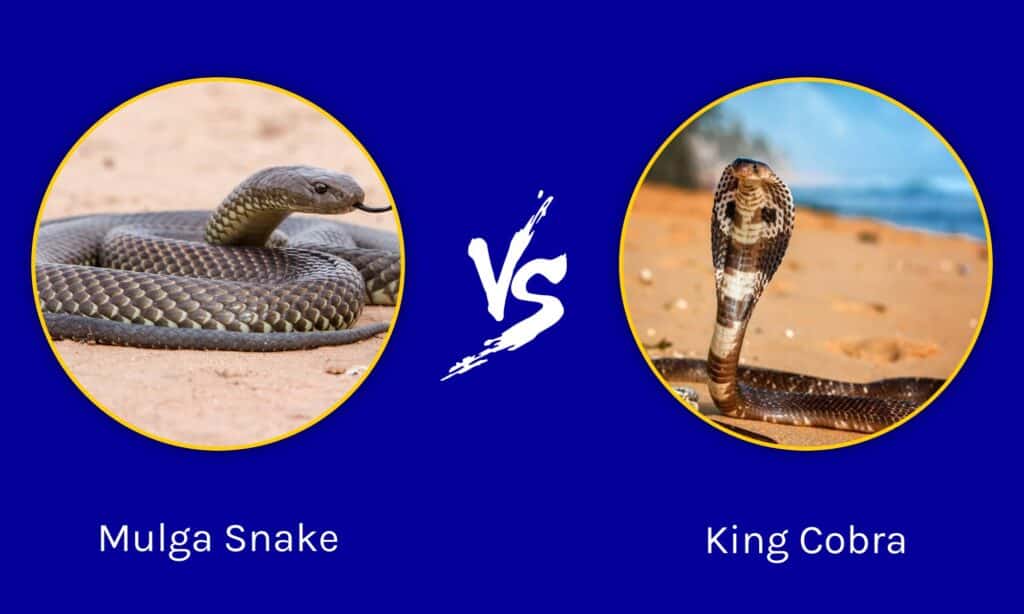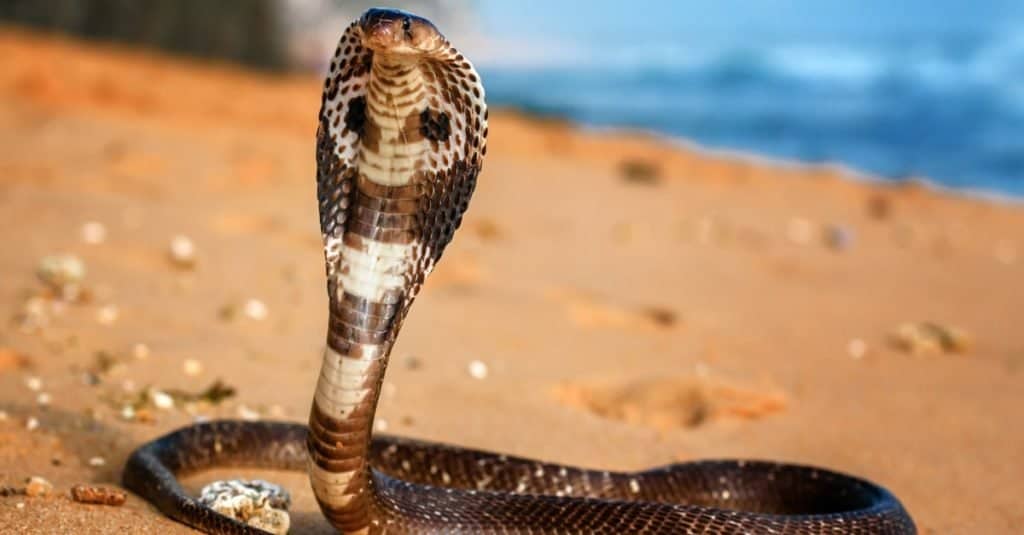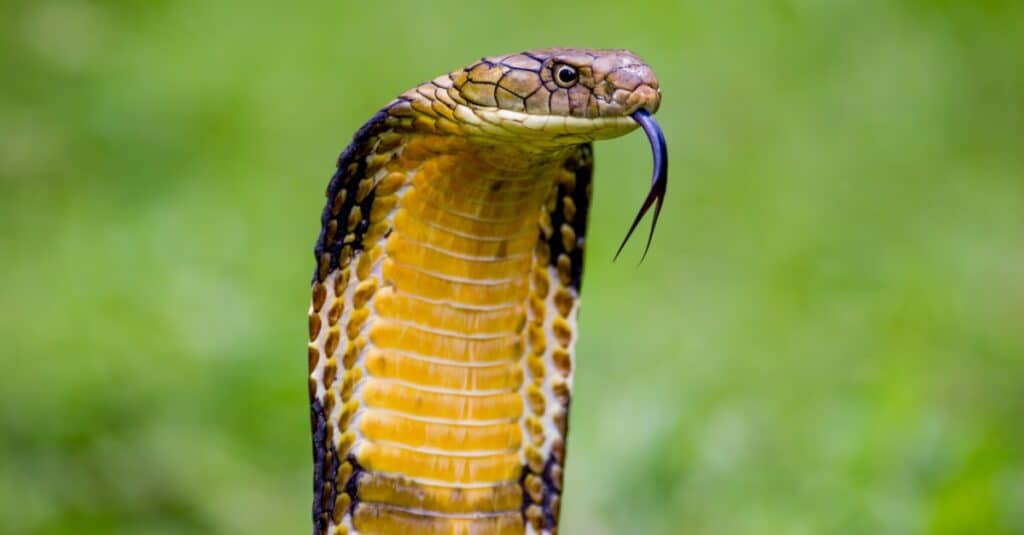Snakes are incredible creatures from their feeding, skin functions, sensory organs, body colors, etc. They are found worldwide, except in Iceland, Greenland, Ireland, Antarctica, and New Zealand. However, not everyone is capable of distinguishing between these creatures. Because snakes come in so many different types, identifying them by their eyes, head form, or skin color isn’t always straightforward.
This article will examine the physical characteristics, behaviors, and appearances of the mulga snake and the king cobra. While they are different species from the same family, they are distinguished by their features and actions.
Comparing a Mulga Snake and a King Cobra

| Mulga Snake | King Cobra | |
|---|---|---|
| Size | Length: About 5 feet long for an adult Mulga Snake, although they can reach 8 to 10 feet. Weight: Between 6.6 to 13.2 pounds. | Length: Typically varies from snake to snake. The average length is between 10 to 19 feet. Weight: About 13 pounds. |
| Distribution | Can be found in most parts of Australia, including the Northern Territory and parts of Queensland, South Australia, Northern Australia, and New South Wales. | They are held captive in most parts of the world, and their origin can be traced back to South and Southeast Asia. |
| Lifespan | Can live for up to 25 years when in captivity. | It has a life expectancy of about 20 years in the wild. |
| Venom resistance | Has some resistance but can be affected by many venoms. | It can also be affected by a lot of venoms. |
| Threat display | The mulga snake pushes up its body and holds its head and flattened neck parallel to the ground in a wide circle. It will hiss noisily as it throws its head and neck from side to side. If you press it any harder, it will lash out and try to bite you. | It warns people by spreading its hood, lifting its head high, making a deep growling hiss, and pulling itself up many feet. |
| Method of attack | Has mycotoxins, which can harm striated muscles and renal cells. They are known to attack both when they are threatened and when not. | It can raise its body several feet off the ground to attack, even from a considerable distance. |
The Key Differences Between Mulga Snakes and King Cobras
The key differences between mulga snakes and king cobras are size, distribution, lifespan, venom resistance, threat display, and method of attack.
The king cobra, despite having cobra in its name and exhibiting hooding, is not a genuine cobra because it differs from the Naja genus in several anatomical features. Instead, it belongs to its own genus, Ophiophagus, whose name comes from its preference for eating other snakes. It has been known to attack bigger snakes, such as pythons. The mulga snake, on the other hand, sometimes known as the king brown snake, is not a real brown snake but rather a member of the black snake family.
The king cobra and mulga snakes, like other snakes, play a vital role in ecosystems by preying on amphibians, reptiles, and small mammals. They help keep wildlife populations in check. Without them, the number of animals that snakes eat would grow to unnaturally high levels, upsetting the balance of the snakes and making the ecosystem less stable.
Now, let’s look at more differences between the two species.
Mulga Snake vs King Cobra: Size

The weight of a typical king cobra is about 13 pounds.
©Vova Shevchuk/Shutterstock.com
The king cobra is larger than the mulga snake, both in terms of weight and length. The weight of a typical king cobra is about 13 pounds, while the length varies from snake to snake. However, it is the world’s longest venomous snake, with an average length of between 10 and 19 feet.
Meanwhile, an adult mulga snake is about 5 feet long, although it can reach lengths of about 8 to 10 feet in the most notable instances. A large adult mulga snake, measuring 8 feet in length, can weigh between 6 and 12 pounds.
Mulga Snake vs King Cobra: Distribution

You can find the mulga snake in most parts of Australia, including the Northern Territory.
©Ken Griffiths/Shutterstock.com
The mulga snake can be found in most parts of Australia, including the Northern Territory. You can also as find them in parts of Queensland, South Australia, Northern Australia, and New South Wales. They are not present in Victoria or Tasmania. Also, they are said to be on the decline or going extinct in several Queensland coastal locations.
King cobras are held captive in most parts of the world. Their origin can be traced back to South and Southeast Asia. These include India, Cambodia, Myanmar, Thailand, Indonesia, Malaysia, Vietnam, Bangladesh, China, Laos, and the Philippines.
Mulga Snake vs King Cobra: Lifespan
The lifespan of both snakes is another difference between them. While the king cobra has a life expectancy of about 20 years in the wild, the mulga snake, when held captive, can live for up to 25 years.
Mulga Snake vs King Cobra: Venom Resistance
Even though both snakes have some level of venom tolerance, they can still be affected by many of the venoms found on the planet.
Mulga Snake vs King Cobra: Threat Display

The mulga snake pushes up its body and holds its head and flattened neck parallel to the ground in a wide circle.
©Ken Griffiths/Shutterstock.com
The Mulga Snake pushes up its body and holds its head and flattened neck parallel to the ground in a wide circle. It will hiss noisily as it throws its head and neck from side to side. If you press it any harder, it will lash out and try to bite you. The menacing show of the king cobra, however, is more dramatic. Broadening its hood, lifting its head high, producing a deep growling hiss, and pulling itself up many feet are all part of its warning display. In some situations, the king cobra can lift itself to one-third of its body length, making it taller than an ordinary man.
Mulga Snake vs King Cobra: Method of Attack

The king cobra has a potent neurotoxic venom that can cause death within 30 minutes of being struck.
©iStock.com/takeo1775
While both animals envenomate their prey, the king cobra can raise its body several feet off the ground to attack, even from a considerable distance. The king cobra has a potent neurotoxic venom that can cause death within 30 minutes of being struck, while the mulga snake has mycotoxins that can harm striated muscles and renal cells. Also, king cobras are known to attack just when they feel challenged, whereas Mulga snakes attack both when they are threatened and when they are not. They have been known to attack victims that are sleeping.
The photo featured at the top of this post is © Wright Out There/Shutterstock.com
Discover the "Monster" Snake 5X Bigger than an Anaconda
Every day A-Z Animals sends out some of the most incredible facts in the world from our free newsletter. Want to discover the 10 most beautiful snakes in the world, a "snake island" where you're never more than 3 feet from danger, or a "monster" snake 5X larger than an anaconda? Then sign up right now and you'll start receiving our daily newsletter absolutely free.
Thank you for reading! Have some feedback for us? Contact the AZ Animals editorial team.







